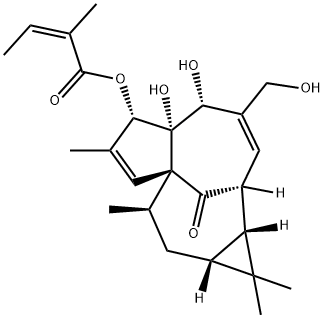Ingenol mebutate
- CAS No.
- 75567-37-2
- Chemical Name:
- Ingenol mebutate
- Synonyms
- Picato;Ingenol mebutate;Ingenol 3-mebutate;Ingenol-3-O-angelate;Ingenol Mebutate, >98%;Ingenol Mebutate (PEP005);Ingenol mebutate USP/EP/BP;PEP005; INGENOL MEBUTATE; I3A;Ingenol-3-O-angelate 75567-37-2;Ingenol-3-angelate Ingenol Mebutate
- CBNumber:
- CB92650628
- Molecular Formula:
- C25H34O6
- Molecular Weight:
- 430.53
- MDL Number:
- MFCD22683801
- MOL File:
- 75567-37-2.mol
| Boiling point | 576.9±50.0 °C(Predicted) |
|---|---|
| Density | 1.26±0.1 g/cm3(Predicted) |
| storage temp. | -20°C |
| solubility | DMSO: soluble15mg/mL, clear |
| form | powder |
| pka | 11.52±0.70(Predicted) |
| color | white to beige |
| Water Solubility | Soluble in 100% ethanol, DMSO, dichloromethane, and methanol. Insoluble in water. |
| Stability | Stable for 1 year as supplied. Solutions in DMSO or ethanol may be stored at -20°C for up to 1 month. |
| NCI Dictionary of Cancer Terms | Picato |
| FDA UNII | 7686S50JAH |
| NCI Drug Dictionary | ingenol mebutate |
| ATC code | D06BX02 |
SAFETY
Risk and Safety Statements
| Symbol(GHS) |   GHS05,GHS06 |
|||||||||
|---|---|---|---|---|---|---|---|---|---|---|
| Signal word | Danger | |||||||||
| Hazard statements | H330-H300-H314 | |||||||||
| Precautionary statements | P260-P271-P284-P304+P340-P310-P320-P403+P233-P405-P501-P260-P264-P280-P301+P330+P331-P303+P361+P353-P363-P304+P340-P310-P321-P305+P351+P338-P405-P501-P264-P270-P301+P310-P321-P330-P405-P501 | |||||||||
| NFPA 704 |
|
Ingenol mebutate price More Price(26)
| Manufacturer | Product number | Product description | CAS number | Packaging | Price | Updated | Buy |
|---|---|---|---|---|---|---|---|
| Sigma-Aldrich | SML1318 | Ingenol-3-angelate ≥95% (HPLC) | 75567-37-2 | 1mg | $173 | 2024-03-01 | Buy |
| Alfa Aesar | J60601 | Ingenol 3-angelate, 98% | 75567-37-2 | 1mg | $306 | 2023-06-20 | Buy |
| Cayman Chemical | 16207 | Ingenol-3-angelate ≥95% | 75567-37-2 | 500μg | $81 | 2024-03-01 | Buy |
| Cayman Chemical | 16207 | Ingenol-3-angelate ≥95% | 75567-37-2 | 1mg | $152 | 2024-03-01 | Buy |
| Cayman Chemical | 16207 | Ingenol-3-angelate ≥95% | 75567-37-2 | 5mg | $553 | 2024-03-01 | Buy |
Ingenol mebutate Chemical Properties,Uses,Production
Ingenol mebutate
Ingenol mebutate (PicatoTM, Leo Pharma), a macrocyclic diterpene ester, is the active constituent in the sap of Euphorbia peplus. Commonly known as radium weed, petty spurge, or milkweed, E. peplus has been used for centuries as a traditional remedy for cutaneous conditions including skin cancer.
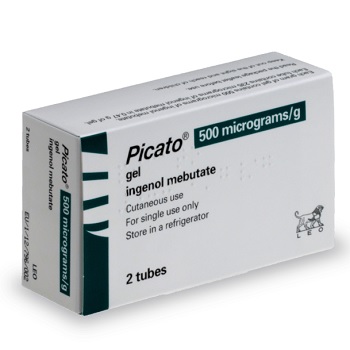
Owing to a substantially shorter course of treatment (2-3 days) and duration of local cutaneous reaction, ingenol mebutate offers an appealing alternative to other topical agents used for the treatment of actinic keratoses.
Mechanism of action
Ingenol mebutate has a dual mechanism of action. Ingenol mebutate first induces rapid and direct cell death within hours of application followed by an acute inflammatory response that eliminates residual tumor cells.
In vitro and in vivo studies on B16 mouse melanoma cells exposed to ingenol mebutate revealed disruption of the cell membrane, loss of mitochondrial membrane potential, and mitochondrial swelling resulting in rapid primary necrosis. As a result of the rapid destruction of tumor cells, a treatment duration of 2–3 days is sufficient. Unlike other anti-cancer agents, ingenol mebutate does not trigger apoptosis, and thus the development of apoptosis resistance in tumor cells is unlikely to compromise its activity.
Following the initial cell necrosis, an acute inflammatory response occurs. Ingenol mebutate activates protein kinase c resulting in the release of pro-inflammatory cyto-kines (IL-1B, IL-8, TNF-alpha), the production of tumor-specific antibodies, an enhanced endothelial adhesion molecule expression, and a substantial infiltration of neutro-phils which generate tumoricidal reactive oxygen intermediates. The end-result is eradication of residual tumor cells via neutrophil mediated antibody depen-dent cellular cytotoxicity (ADCC). The elimination of resid-ual tumor cells is thought to be essential in preventing relapse. Furthermore, the inflammatory response appears to confer a favorable cosmetic outcome via expedited healing and a rapid regeneration of the normal cutaneous architecture.
Clinical Use
Ingenol mebutate is the active ingredient in the sap from the Euphorbia peplus plant that has been used to treat a variety of skin lesions including warts, AKs, and NMSC. Recent clinical trials have demonstrated that two or three applica-tions of ingenol mebutate is effective in clearing AKs and BCCs. The efficacy of the treatment increased in a dose dependent manner with only mild dose dependent dermatological side effects, confirming that short term use of ingenol mebutate is safe when treating a variety of skin lesions.
Dosage and Administration
Ingenol mebutate (chemical structure C25H34O6) has been formulated as a topical gel. Each gram contains 150 or 500 mcg of ingenol mebutate in a base of isopropyl alcohol, hydroxyethyl cellulose, citric acid monohydrate, sodium citrate, benzyl alcohol, and purified water.
For the indication of actinic keratoses. The 0.015 % gel is applied once daily for three consecutive days (face or scalp) while the 0.05 % gel is applied once daily for two consecu-tive days (trunk or extremities).
side effects
The most common side effects of ingenol mebutate were application-site reactions including erythema, scale, crust-ing, edema, vesiculation, erosions, ulceration, pruritus, pain, and irritation. Skin reactions typically occurred within 1 day of treatment initiation, peaking in intensity 1 week following application, and resolving within 2 weeks on the face/scalp and 4 weeks on the trunk/extremities.
Reports of periocular pain, edema, ptosis have been docu-mented. Prompt hand washing after application and avoid-ance of contact with the eyes is recommended.
No evidence of skin sensitization, photoirritation, or pho-toallergic potential has been demonstrated.
Ingenol mebutate is pregnancy category C. It is unknown if ingenol mebutate is secreted in the breast milk of lactating women.
Description
Ingenol mebutate (also known as PEP005) was approved in January 2012 by the US FDA for the topical treatment of actinic keratoses (AK). Ingenol mebutate also received approval in 2012 in the European Union, Australia, and Brazil for the same indication. Ingenol mebutate, a diterpene ester natural product, is the active agent in the sap of the plant Euphorbia peplus, which has long been used as a traditional remedy for skin lesions. Ingenol mebutate has a novel mechanism of action involving initial plasma membrane disruption, rapid loss of mitochondrial membrane potential, and cell death by primary necrosis within 1 h; a subsequent tumor-specific immune response results in antibodydependent cellular toxicity that eliminates residual cells. Ingenol mebutate is obtained by extraction from the dried, milled aerial parts of Euphorbia peplus followed by a series of purification steps.
Originator
Peplin (United States)
Uses
Ingenol 3-Angelate is used as a PKC activator, anticancer, and immunostimulant compound. It is also used to exhibits antileukemic activity, induces nuclear translocation of PKCδ, and induces apoptosis in acute myeloid leukemia (AML) cell lines and primary AML blast cells. Also displays antiproliferative effects and induces apoptosis in Colo205 cells.
Uses
Ingenol 3-Angelate is known to exhibit antitumor activities which induces plasma membrane and mitochondrial disruption and necrotic cell death.
Definition
ChEBI: A tetracyclic diterpenoid ester obtained by formal condensation of the carboxy group of (2Z)-2-methylbut-2-enoic (angelic) acid with the 3-hydroxy group of ingenol. Used for the topical treatment of actinic keratosis.
brand name
Picato
Biochem/physiol Actions
Ingenol-3-angelate, is a phorbol ester-like compound or a diacylglycerol analog that is used in the treatment of several disorders like skin cancer. It is also known as PEP005. Ingenol-3-angelate stimulates the initiation of the enzyme by providing PKCs (protein kinase C) to cellular membranes.
Clinical Use
Ingenol mebutate is a diterpene ester which was approved in the US, EU, Austrailia, and Brazil for the treatment of actinic keratosis, a disease stage associated with sun exposure which can potentially develop into cancer. The drug, which is marketed by LEO Pharma A/S as Picato®, is administered as a topical gel (0.015%, 0.05%) which has been proven effective in treating face-, scalp-, and trunklocalized actinic keratosis in four randomized, double-blind, vehicle-controlled, multicenter studies. The drug exhibits mild side effects limited to application-site conditions (e. g. irritation, pain, pruritus), and no detectable concentrations of ingenol mebutate or two of its metabolites were found in blood samples.94 Traditionally used as a home remedy for various skin conditions, the ingenol mebutate, also referred to as ingenol 3-angelate, is the main active constituent of sap from the plant Euphorbia pelpus.95 From natural extractions, 17 kg of fresh E. pelpus afforded 7 g of ingenol 3-angelate as an oil, which upon further purification was deemed insufficient for process-scale production.
Synthesis
Although several synthetic approaches to the ingenol family of terpenes have been reported,97-113 Liang and coworkers at LEO Pharma have reported a semisynthesis of the API from naturally-occurring ingenol. This natural product?ˉs accessibility from the seeds of E. lathyris renders it widely commercial on scale. The conversion of ingenol to ingenol mebutate involves a protection, esterification, and deprotection strategy to procure scale quantities of the drug.114 Conversion of ingenol (87) to the corresponding 5,20-acetonide 88 proceeded in good yield using a protocol modified from the original conditions described by Hecker. A considerable amount of study was conducted by Liang to affect efficient angeloylation with minimal isomerization of the double-bond to the corresponding Z-isomer (tiglate). It was found that angelic anhydride 89 (which is a commercially available reagent, but for process scale was prepared immediately prior to usage from the self-condensation of 99.5% pure angelic acid with 0.5 equivalents of DCC) in the presence of LHMDS gave acetonide 90 in over 95% conversion and was practically free of the undesired tiglate bi-product after recrystallization (73% yield).96 Deprotection of the acetonide 90 was affected using phosphoric acid and after three recrystallizations, ingenol mebutate (XIV) was produced on multigram scale in a combined yield of 37% starting from ingenol 87.
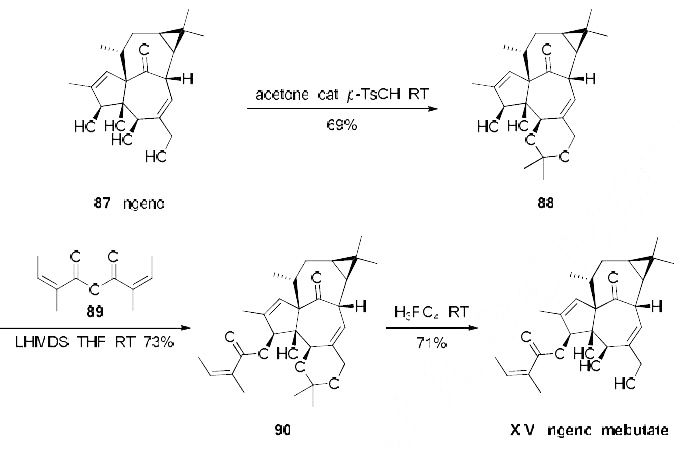
target
gp120/CD4 | HIV | PKC | P-gp | NF-kB | ERK
storage
-20°C
References
References/Citations
Ingenol mebutate Preparation Products And Raw materials
| Supplier | Tel | Country | ProdList | Advantage | |
|---|---|---|---|---|---|
| Hebei Mojin Biotechnology Co., Ltd | +8613288715578 | sales@hbmojin.com | China | 12453 | 58 |
| Shanghai Zheyan Biotech Co., Ltd. | 18017610038 | zheyansh@163.com | CHINA | 3620 | 58 |
| career henan chemical co | +86-0371-86658258 | sales@coreychem.com | China | 29914 | 58 |
| Chengdu GLP biotechnology Co Ltd | 028-87075086 13350802083 | scglp@glp-china.com | CHINA | 1824 | 58 |
| Chengdu Biopurify Phytochemicals Ltd. | +8618080483897 | sales@biopurify.com | China | 3424 | 58 |
| Hubei Jusheng Technology Co.,Ltd. | 18871490254 | linda@hubeijusheng.com | CHINA | 28180 | 58 |
| Hebei Guanlang Biotechnology Co., Ltd. | +86-19930503282 | alice@crovellbio.com | China | 8822 | 58 |
| NanJing Spring & Autumn Biological Engineering CO., LTD. | +8613815430202 | sale02@cqherb.com | CHINA | 376 | 58 |
| Chongqing Chemdad Co., Ltd | +86-023-61398051 +8613650506873 | sales@chemdad.com | China | 39916 | 58 |
| Neostar United (Changzhou) Industrial Co., Ltd. | +86-519-519-85557386 | marketing1@neostarunited.com | China | 8349 | 58 |
View Lastest Price from Ingenol mebutate manufacturers
| Image | Update time | Product | Price | Min. Order | Purity | Supply Ability | Manufacturer | |
|---|---|---|---|---|---|---|---|---|
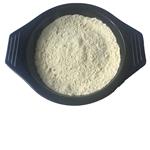 |
2023-06-26 | Ingenol mebutate
75567-37-2
|
US $0.00 / KG | 1KG | 99% | 50000KG/month | Hebei Mojin Biotechnology Co., Ltd | |
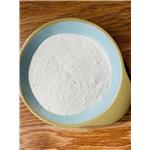 |
2023-02-13 | Ingenol 3-mebutate
75567-37-2
|
US $10.00 / KG | 1KG | 99% | 50MT | Hebei baicao biology science and technology co., ltd | |
 |
2022-02-14 | Ingenol-3-O-angelate 75567-37-2
75567-37-2
|
US $1500.00 / g | 10mg | 98.00% | 1000.00 kgs | NanJing Spring & Autumn Biological Engineering CO., LTD. |
-

- Ingenol mebutate
75567-37-2
- US $0.00 / KG
- 99%
- Hebei Mojin Biotechnology Co., Ltd
-

- Ingenol 3-mebutate
75567-37-2
- US $10.00 / KG
- 99%
- Hebei baicao biology science and technology co., ltd
-

- Ingenol-3-O-angelate 75567-37-2
75567-37-2
- US $1500.00 / g
- 98.00%
- NanJing Spring & Autumn Biological Engineering CO., LTD.
75567-37-2(Ingenol mebutate)Related Search:
1of3





